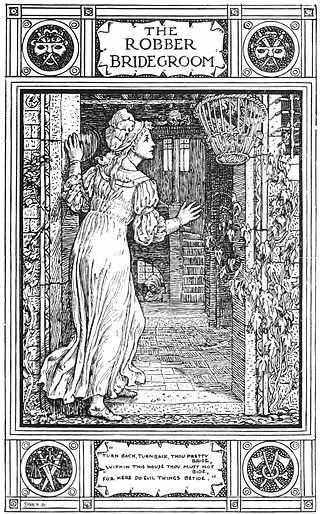
In mythology, folklore and speculative fiction, shapeshifting is the ability to physically transform oneself through unnatural means. The idea of shapeshifting is found in the oldest forms of totemism and shamanism, as well as the oldest existent literature and epic poems such as the Epic of Gilgamesh and the Iliad. The concept remains a common literary device in modern fantasy, children's literature and popular culture. Examples of shapeshifters are vampires and werewolves.

"The Twelve Dancing Princesses" is a German fairy tale collected by the Brothers Grimm and published in Grimm's Fairy Tales in 1815. It is of Aarne-Thompson type 306.

"East of the Sun and West of the Moon" is a Norwegian fairy-tale. It was included by Andrew Lang in The Blue Fairy Book (1889).

"The Black Bull of Norroway" is a fairy tale from Scotland. A version titled "The Black Bull of Norroway" in the 1870 edition of Popular Rhymes of Scotland was reprinted in an Anglicised version by Joseph Jacobs in his 1894 book More English Fairy Tales.
The Brown Bear of Norway is an Irish fairy tale collected by Patrick Kennedy which appeared in his Legendary Fictions of the Irish Celts (1866). It was later included by Andrew Lang in his anthology The Lilac Fairy Book (1910), though Lang misattributed his source as West Highland Tales.

"The Robber Bridegroom" is a German fairy tale collected by the Brothers Grimm, tale number 40. Joseph Jacobs included a variant, Mr Fox, in English Fairy Tales, but the original provenance is much older; Shakespeare alludes to the Mr. Fox variant in Much Ado About Nothing, Act 1, Scene 1:
Fair, Brown and Trembling is an Irish fairy tale collected by Jeremiah Curtin in Myths and Folk-lore of Ireland and Joseph Jacobs in his Celtic Fairy Tales.
"The Pig King" or "King Pig" is an Italian literary fairy tale written by Giovanni Francesco Straparola in his The Facetious Nights of Straparola. Madame d'Aulnoy wrote a French, also literary, variant, titled Prince Marcassin.
Jackal or Tiger? is an Indian fairy tale. Andrew Lang included it in The Olive Fairy Book.
The Story of Zoulvisia is an Armenian fairy tale published in Hamov-Hotov, a collection of Armenian fairy tales by ethnologue and clergyman Karekin Servantsians published in 1884. Andrew Lang included it in The Olive Fairy Book. The story was also featured in the book Once Long Ago, by Roger Lancelyn Green and illustrated by Vojtech Kubasta.
Asmund and Signy is an Icelandic fairy tale published by Scandinavist Josef Calasanz Poestion in Islandische Märchen. Andrew Lang included it in The Brown Fairy Book.

Lovely Ilonka is a Hungarian fairy tale published in Ungarische Märchen by Elisabet Róna-Sklarek. Andrew Lang included it in The Crimson Fairy Book.
The Daughter of the Skies is a Scottish fairy tale collected by John Francis Campbell in Popular Tales of the West Highlands, listing his informant as James MacLauchlan, a servant from Islay.

"The Love for the Three Oranges" or "The Three Citrons" is an Italian literary fairy tale written by Giambattista Basile in the Pentamerone. It is the concluding tale, and the one the heroine of the frame story uses to reveal that an imposter has taken her place.
"The True Bride" or "The True Sweetheart" is a German fairy tale collected by the Brothers Grimm in Grimm's Fairy Tales as tale 186.

"The Two Kings' Children" is a German fairy tale collected by the Brothers Grimm in Grimm's Fairy Tales, tale number 113.

The White Deer is a 96 page children's novel written by James Thurber in 1945. It is a fairy tale about the quest of the three sons of King Clode – Thag and Gallow, the hunters, and Jorn, the poet – who are set perilous tasks to win the heart and hand of a princess who had once been a beautiful white deer, but lost her memories.

The Princess and the Pea is a 2002 animated musical fantasy film adaptation of the popular 1835 fairy tale "The Princess and the Pea" by Hans Christian Andersen. The film was directed by Mark Swan. It was released August 16, 2002 as an American-Hungarian production of Feature Films for Families & Swan Productions. The script writers were Forrest S. Baker and Ken Cromar.

Princess of the Midnight Ball is a 2009 young adult fantasy novel written by Jessica Day George. It is based on the fairy tale "The Twelve Dancing Princesses".
The Anar Pari, or Pomegranate Fairy is an Indian folktale collected by Alice Elizabeth Dracott from Simla. The tale is a local form of tale type ATU 408, "The Love for Three Oranges", of the international Aarne-Thompson-Uther Index. As with The Three Oranges, the tale deals with a prince's search for a bride that lives in a fruit, who is replaced by a false bride and goes through a cycle of incarnations, until she regains physical form again. Variants are known across India with other species of fruits.










